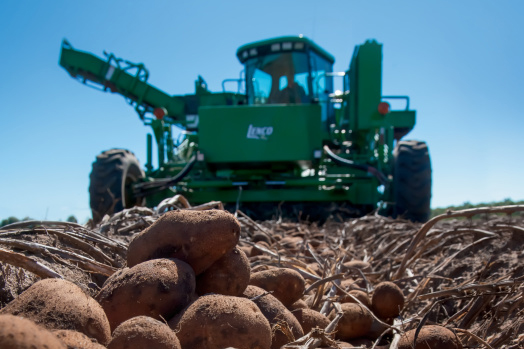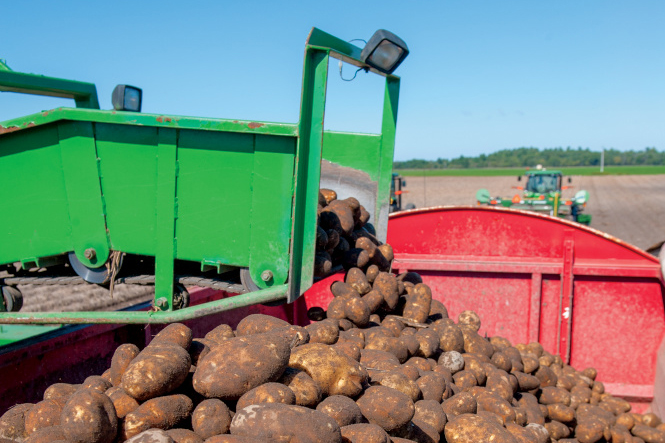Home > Wisconsin > Wisconsin Environment > Wisconsin Potato Industry Rooted in Diversity, Sustainability
Wisconsin Potato Industry Rooted in Diversity, Sustainability
In partnership with: Wisconsin Department of Agriculture, Trade and Consumer Protection.
 According to the U.S. Department of Agriculture, potatoes remain America’s favorite and most-consumed vegetable. That’s good news for potato farmers in Wisconsin, which ranks as one of the top states for potato production, just behind Idaho and Washington.
According to the U.S. Department of Agriculture, potatoes remain America’s favorite and most-consumed vegetable. That’s good news for potato farmers in Wisconsin, which ranks as one of the top states for potato production, just behind Idaho and Washington.
Location Is Key
The state’s mild climate and sandy soil make it the perfect place for a wide range of potato varieties. In fact, Wisconsin produces more varieties than any other state.
“The sandy soil that we have in this part of the state in combination with irrigation from our underground aquifer make for good potato growing,” says Andy Diercks, a fourth-generation farmer who operates Coloma Farms in Coloma with his dad, Steve. “Potatoes are susceptible to lots of diseases and stresses, so the combination of irrigation and sandy soils allows us to manage those conditions as well as possible. Our proximity to the East Coast is also an advantage of growing in Wisconsin versus Idaho, Colorado and Washington.”
The Diercks family owns 2,700 acres, on which they grow roughly 800 acres of potatoes, along with corn and soybeans. “We grow potatoes for three different supply chains – fresh for grocery stores and restaurants, frozen for fries and tater tots and chips,” Diercks says. “We grow between 8 and 10 varieties of potatoes, including Norland red; Superior white; Alegria and Jelly yellow; and Goldrush and Silverton russet potatoes for the fresh market.”
Dick Okray, owner of Okray Family Farms in Plover, also has a long family history in Wisconsin potato farming. His family began growing potatoes in 1905 as Joseph Okray & Bros. Co. Today, the farm grows 1,770 acres of russet, red and yellow varieties for the fresh retail market. Okray says in addition to Wisconsin’s climate, soil and location, the availability of a skilled workforce has proven a major advantage for the company.
“We are blessed with long summer days, sandy soils and abundant water. It also helps to be close to our markets – Minneapolis, Chicago, Indianapolis and most Midwestern cities. But a talented workforce is essential. Our crew are seasoned veterans,” Okray says.
 Research Yields Innovation
Research Yields Innovation
Another advantage of farming in Wisconsin is the access to research and development through the University of Wisconsin.
“I probably wouldn’t still be farming were it not for the relationship our farm and our grower association (Wisconsin Potato and Vegetable Growers Association) has with the University of Wisconsin-Madison,” Diercks says. “We have the best and most extensive potato research team in North America, and we work cooperatively with them to grow food in the best and most efficient ways possible.”
Another resource for growers, the Peninsular Agricultural Research Station in Sturgeon Bay, serves as a field laboratory for vegetable research. The station is also home to the NRSP-6 US Potato Genebank, which maintains the world’s largest collection of wild and cultivated potato species. The facility collects, classifies, evaluates and distributes some 5,000 samples of potato species.
The Wisconsin Institute for Sustainable Technology at the University of Wisconsin-Stevens Point works with the potato industry to help growers develop more sustainable farming practices.
“We educate our team on an ongoing basis, using the latest technology from UW-Madison
and other collaborators, public and private,” Okray says. “Miles of windbreaks, low-till projects, woodland enhancement, as well as collaboration with the Wisconsin Institute for Sustainable Technology at UWSP, are just a few of our ongoing projects. Growing more with less is the ultimate goal.”
Dierck says Wisconsin potato farmers understand the importance of sustainability.
“All the potato growers in Wisconsin are family farms, and we all want to provide our children and grandchildren the opportunity to care for our farms the way we have. We want them to have the tools and resources to make better choices than we can make now. That requires constantly working with other growers, researchers and partners, along with new technology and practices to grow food better,” he says.
The goal, he adds, is to grow food with zero impact on the environment, both on and around the farm, “because we have a responsibility to leave our little patch of Earth the same or better than when we started farming it.”



